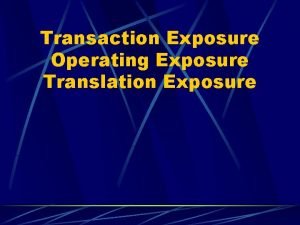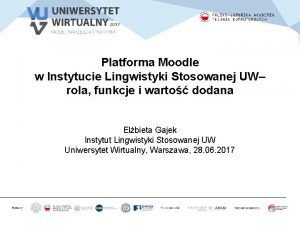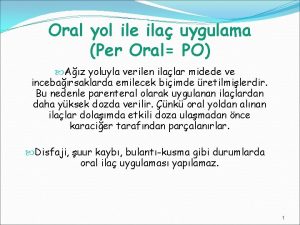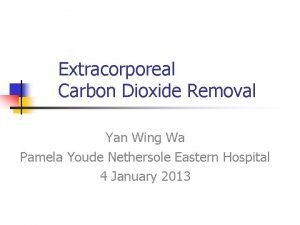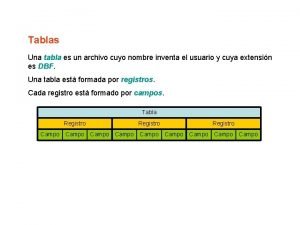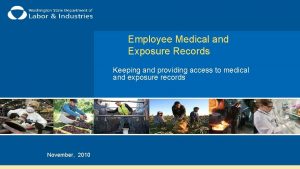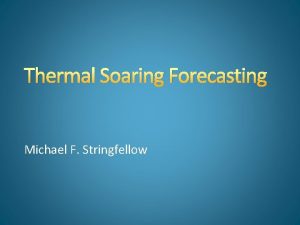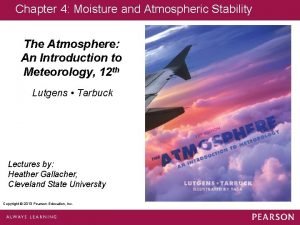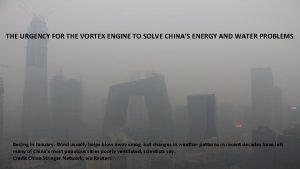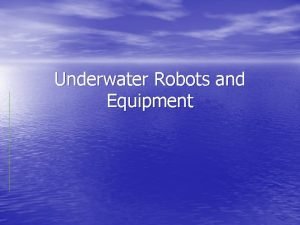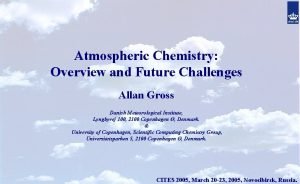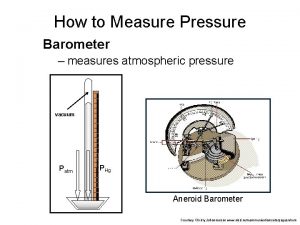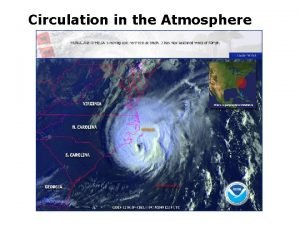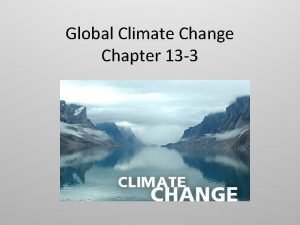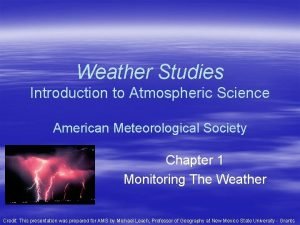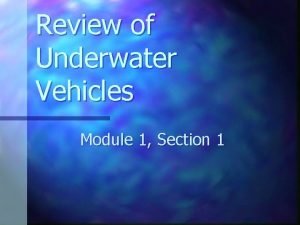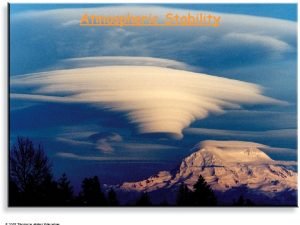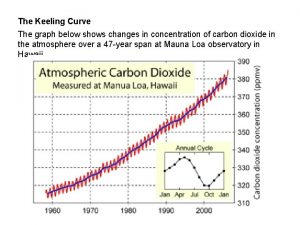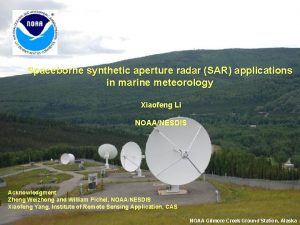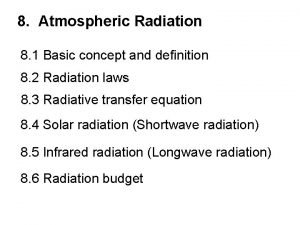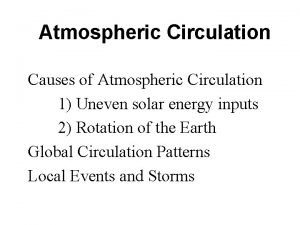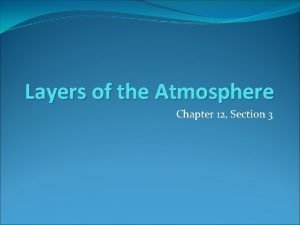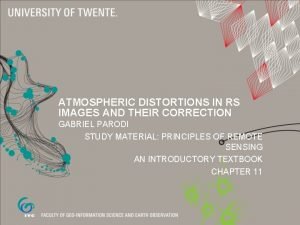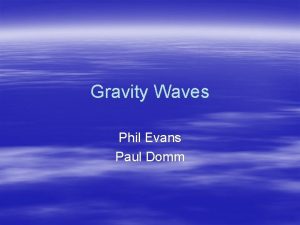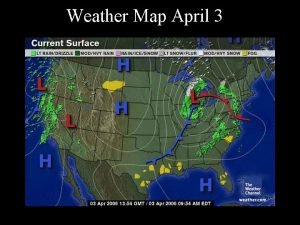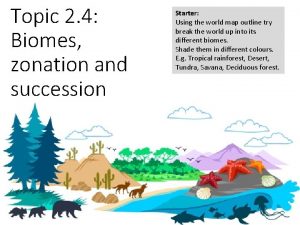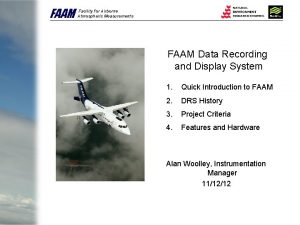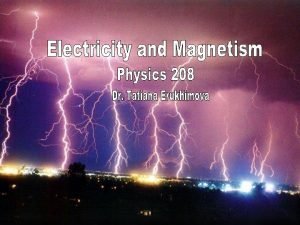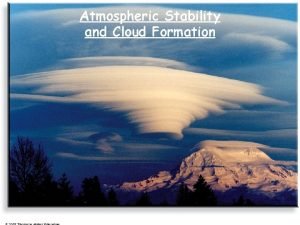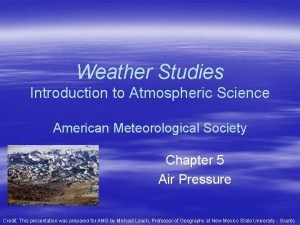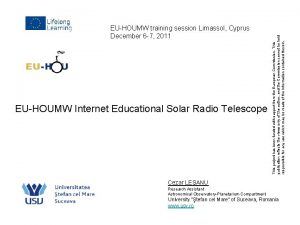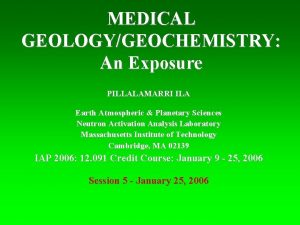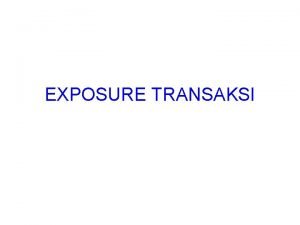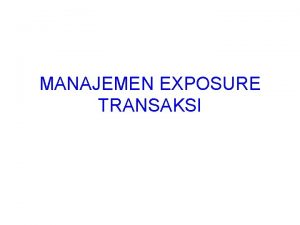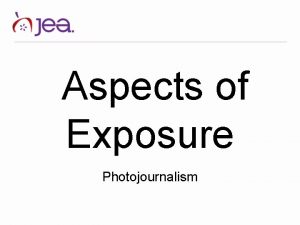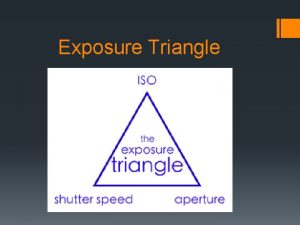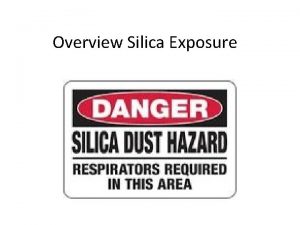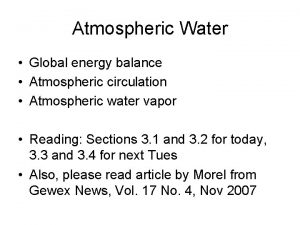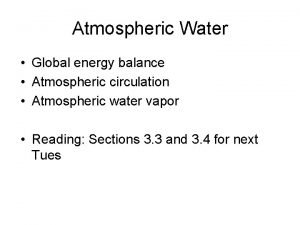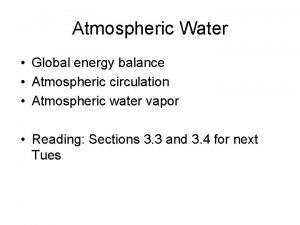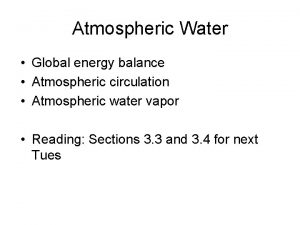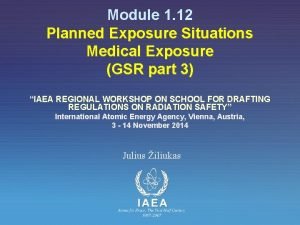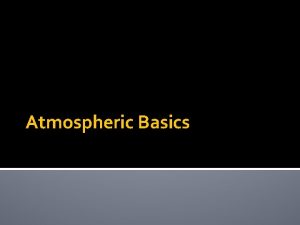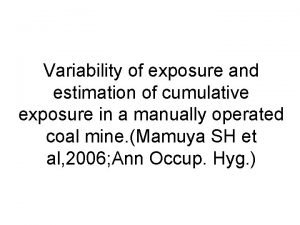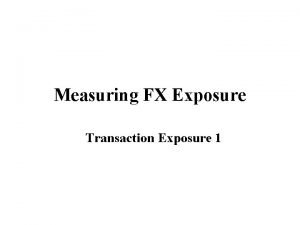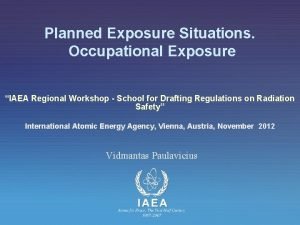MEDICAL GEOLOGYGEOCHEMISTRY An exposure PILLALAMARRI ILA Earth Atmospheric
















































- Slides: 48

MEDICAL GEOLOGY/GEOCHEMISTRY: An exposure PILLALAMARRI ILA Earth Atmospheric & Planetary Sciences Neutron Activation Analysis Laboratory Massachusetts Institute of Technology Cambridge, MA 02139 IAP 2006: 12. 091 Credit Course: January 9 - 25, 2006 Session 2 A, January 11, 2006: IAP 2006, 12. 091 Session 2 A: P. ILA

Session 2 January 11, 2006 Objective Jan 11: 10 AM ‐ 11 PM Session 2 A Review of radioactivity – radionuclides concepts Naturally Occurring Radioactive Materials (NORM) Primordial‐Cosmogenic‐Anthropogenic Technologically Enhanced Naturally Occurring Radioactive Materials (TENORM) TENORMs Contributors TENORMs Radioactivity 11 AM ‐ 12 PM Session 2 B Radon: Frequently Asked Questions (FAQs) Myths and Facts Radon potential maps of USA and Massachusetts Radon in drinking water Radon in indoor and outdoor air Radon resistant new construction Radon Detection January 11, 2006: IAP 2006, 12. 091 Session 2 A: P. ILA

Review of Radioactivity – Radionuclides Concepts n n Atomic Nucleus Review of radioactivity and radionuclides concepts Radioactive Decay Units of Radiation Dose and Exposure

Review of radioactivity and radionuclides concepts Atomic Nucleus Material Compounds Elements Atoms (Neutrons + Protons) + Electrons {Nucleus} Element X is depicted by A A = Mass Number N = Neutron Number Z = Atomic Number (Proton Number) X Z N A=Z+N January 11, 2006: IAP 2006, 12. 091 Session 2 A: P. ILA

Review of radioactivity and radio-nuclides concepts … Radio-isotopes & Radio-nuclides Mass Charge Neutron 1. 008665 u No electrical charge Proton 1. 007277 u Positive charge Electron 0. 000548 u Negative charge [Ref: Basic Nuclear Engineering, A. R. Foster and R. L. Wright, Jr. , Appendix B, pp 461] Nuclides: Characterized by atomic number Z and mass number A. Isomer – Same N, Z, A but exists in an excited state for a period of time. 60 60 m Ex: Co ( T ½ = 5. 26 y) and Co (T ½ = 10. 48 m). 27 33 Isotope – Same Z number, but different N. 59 60 Ex: Co Co 27 32 27 33 Isobar – Same A number, but different Z. 14 14 Ex: C , N 6 8 7 7 Isotone – Same N number ( also means same A-Z). 14 15 16 Ex: C , N , O 6 8 7 8 8 8 Nuclides: Stable and Radioactive ; Radioactive Nuclides: Naturally occurring and Artificially produced. January 11, 2006: IAP 2006, 12. 091 Session 2 A: P. ILA

Review of radioactivity and radio-nuclides concepts … Radioactive Decay Radioactivity is produced when unstable nuclei decay. The disintegration of radio-nuclides releases excess energy in the form of nuclear radiations. Radioactive decay takes place in several ways emitting radiation such as: n Alpha rays n Beta (negative and positive) rays n Gamma rays n Neutrons n Neutrinos n Proton decay n Internal conversion electrons n Characteristic x-rays n Fission fragments The heavy radioactive elements and their decay products predominantly emit three types of radiation: Alpha rays, Beta rays, Gamma rays January 11, 2006: IAP 2006, 12. 091 Session 2 A: P. ILA

Review of radioactivity and radio-nuclides … Radioactive Decay Alpha decay followed by gamma decay: Alpha particle is The unstable isotope decays to by alpha and gamma radiation. The atomic number decreases by 2 and mass number by 4. January 11, 2006: IAP 2006, 12. 091 Session 2 A: P. ILA

Alpha decay of 234 U to 230 Th Table 1: Alpha decay of 234 U to 230 Th (shown in the format of chart of nuclides). The atomic number Z reduces by 2. The neutron number N reduces by 2. The mass number A reduces by 4. January 11, 2006: IAP 2006, 12. 091 Session 2 A: P. ILA

Review of radioactivity and radionuclides concepts … Radioactive Decay Beta decay followed by gamma decay. Beta particle is electron ejected by excited nuclei. Their charge can be positive or negative. The radioactive isotope decays to by beta and gamma radiation. Neutrinos are also emitted. A neutron is transformed into proton. The atomic number increases by 1 and mass number remains unchanged. January 11, 2006: IAP 2006, 12. 091 Session 2 A: P. ILA

Beta decay of 40 K to 40 Ca Table 2: Beta decay of 40 K to 40 Ca (shown in the format of chart of nuclides). The atomic number Z increase by 1. The neutron number N reduces by 1. The mass number A remains unchanged. January 11, 2006: IAP 2006, 12. 091 Session 2 A: P. ILA

Review of radioactivity and radio-nuclides concepts … n Gamma rays (γ) are emitted when an excited nucleus de-excites, by the transition from an excited energy state to a lower energy state. Gamma-rays have well defined energies and their emission often is accompanied by nuclear reactions and nuclear decays. n Alpha particles (α) are 4 He particles with two protons and two neutrons. The atomic number (Z) of the resultant nucleus is reduced by two units, the mass number is reduced by 4 units. n Negative Beta particles (β-) or negatrons are emitted when neutron is transformed into a proton during the nuclear transformation. Negative beta particles are electrons formed during nuclear transformation, hence are of nuclear origin. The atomic number (Z) of the resultant nucleus is one unit greater, but the mass number is unchanged. January 11, 2006: IAP 2006, 12. 091 Session 2 A: P. ILA

Figure by MIT OCW. Figure 1: Gamma and beta decay scheme of 60 m. Co and 60 Co. January 11, 2006: IAP 2006, 12. 091 Session 2 A: P. ILA

Figure by MIT OCW. Figure 2: Pictorial depiction of simultaneous alpha, beta and gamma emissions January 11, 2006: IAP 2006, 12. 091 Session 2 A: P. ILA

Review of radioactivity and radio-nuclides concepts … Units of Radiation Dose and Exposure n Radioactivity is measured in unit of disintegration per second (dps). 1 Becquerel is 1 Bq = 1 dps 1 Curie is 1 Ci = 3 x 1010 dps January 11, 2006: IAP 2006, 12. 091 Session 2 A: P. ILA

Review of radioactivity and radio-nuclides concepts … Units of Radiation Dose and Exposure n n The amount of radiation is usually referred to as Dose is different from Exposure. The quantities and units of Radiation Dose and Exposure are not simple but are complex involving various parameters such as type of radiation, absorbed dose (D), quality factor (Q), any modifying factor (N), etc. After going through an evolution in a period of more than a half a century, the current units designated by SI (Système International) Unit of Dose Equivalent is 1 Sievert = 1 Sv (1 Joule/kg) Unit of Dose is 1 Gray = 1 Gy (1 Joule/kg) 1 Gy = 100 rad; 1 rad = 0. 01 Joule/kg 1 Sv = 100 rem; 1 rem = rad x quality factor Note: rad refers to any material and any radiation. Ref: P 126 Basic Nuclear Engineering; P 42 Environmental Radioactivity Merrill Eisenbud and Giesell. January 11, 2006: IAP 2006, 12. 091 Session 2 A: P. ILA

Review of radioactivity and radio-nuclides concepts … n NORM - Naturally Occurring Radioactive Material. n TENORM -Technologically-Enhanced Naturally Occurring Radioactive Material. January 11, 2006: IAP 2006, 12. 091 Session 2 A: P. ILA

Naturally Occurring Radioactive Materials (NORM) Primordial n Cosmogenic n Anthropogenic n January 11, 2006: IAP 2006, 12. 091 Session 2 A: P. ILA

Naturally Occurring Radioactive Materials n n The earth is radioactive and the world we live in, the environment around is radioactive. Radioactive elements can be categorized as Primordial – present even before or ever since the existence of the Earth. Cosmogenic - formed as a result of cosmic ray interactions. Anthropogenic - enhanced or formed due to technology, human activities. January 11, 2006: IAP 2006, 12. 091 Session 2 A: P. ILA

Characteristics of Primordial elements n n n long lived most half-lives of the order of millions of years; must have been left-over on the earth, because the radioactivity decays to very minute levels usually after 30 half-lives. January 11, 2006: IAP 2006, 12. 091 Session 2 A: P. ILA

List of some more Primordial Radio-nuclides January 11, 2006: IAP 2006, 12. 091 Session 2 A: P. ILA

The uranium and thorium decay series Detailed information of radioactive decay of 235 U, 238 Uand 232 Th, and their daughter products, the corresponding half-life of each and the decay sequence are provided in many text books and web sites. References: 1) Figure 13. 1 235 U radioactive decay chain. Figure 13. 2 238 U radioactive decay chain. Figure 13. 3 232 Th radioactive decay chain. Chapter 13. Nuclear techniques for the determination of uranium and thorium and their decay products, A hand book of silicate rock analysis, P. J. Potts. 2) http: //www. health. state. ny. us/nysdoh/radon/chain. htm January 11, 2006: IAP 2006, 12. 091 Session 2 A: P. ILA

Cosmogenic Radioactivity n Cosmic radiation: v v n �� Primary cosmic radiation �� Secondary cosmic radiation Primary cosmic radiation: Extremely high energy particles (up to 1018 e. V), and are mostly protons, and some larger particles. Major percentage of it comes from outside the solar system and exists throughout space. Some of the primary cosmic radiation is from the sun, produced during solar flares. January 11, 2006: IAP 2006, 12. 091 Session 2 A: P. ILA

Table 3. K, Th and U Concentrations and activities in rocks and soils 40 K 232 Th 238 U Material % Bq/Kg ppm Bq/Kg Ppm Bq/Kg Basalt (crustal average) 0. 8 300 3. 0 -4. 0 10. 0 -15. 0 0. 5 -1 7. 0 -10. 0 Granite (crustal average) >4 >1000 17 70 3 40 Shale sandstones 2. 7 800 12 50 3. 7 40 Clean quartz <1 <300 <2 <8 <1 <10 Beach sands <1 <300 6 25 3 40 Carbonate rocks 0. 3 70 2 8 2 25 Continental crust (average) 2. 8 850 10. 7 44 2. 8 36 Soil (average) 1. 5 400 9 37 1. 8 22 0. 3 -4. 5 70 -1500 1. 6 -20 7 -80 0. 5 -4. 7 7 -60 Igneous rocks Sedimentary rocks All racks (range) Based on: Table 6 -6, pp 140, Environmental Radioactivity from Natural, Industrial and Military Sources. January 11, 2006: IAP 2006, 12. 091 Session 2 A: P. ILA

Cosmogenic Radioactivity Cosmic radiation consisting of high speed heavy particles and high energy photons and muons permeates all of space, the source being primarily outside our solar system. The cosmic radiation interacts with the upper atmosphere, and produces cosmogenic radioactive nuclides. They can have long half-lives, but the majority have shorter half-lives than the primordial nuclides. January 11, 2006: IAP 2006, 12. 091 Session 2 A: P. ILA

Cosmogenic Radioactivity … n The primary radiation that originate in outer space and impinge isotropically on top of the earth’s atmosphere consist of 85% protons, 14% alpha particles, 1% of nuclei between atomic number Z from 4 to 26. n Primary radiation is highly penetrating with energies in the range 1010 e. V to 1019 e. V. n The major source of cosmic radiation is galactic in origin and a small amount is of solar origin. However, solar flares (in cycles of 11 years) contribute significantly to cosmic radiation. January 11, 2006: IAP 2006, 12. 091 Session 2 A: P. ILA

Cosmogenic Radioactivity… n Secondary Radiation: Not much of the primary cosmic radiation penetrates the Earth's surface. The vast majority of it interacts with the atmosphere. When the interaction takes place, it produces the secondary cosmic radiation, or that is detected on the Earth. The interactions produce other lower energy radiations in the form of photons, electrons, neutrons, muons, etc. which the surface of the Earth. January 11, 2006: IAP 2006, 12. 091 Session 2 A: P. ILA

Cosmogenic Radioactivity … n n The atmosphere and the Earth's magnetic fields shield the Earth from cosmic radiation; thereby reduced amount reaches the Earth's surface. Thus the annual dose from cosmic radiation dependent on the altitude of the location. Dose from cosmic radiation to the U. S. , to the average person is about 27 mrem per year; for every 6, 000 foot increase in elevation, the dose roughly doubles. January 11, 2006: IAP 2006, 12. 091 Session 2 A: P. ILA

Cosmogenic Radioactivity … Figure 3 : Conceptual rendering of primary and secondary cosmic radiation isotropically surrounding the Earth. (not drawn to scale) January 11, 2006: IAP 2006, 12. 091 Session 2 A: P. ILA

Cosmogenic Radioactivity … n Typical Cosmic Radiation Dose rates: • • • n n 4 µR/hr in the Northeastern US 20 µR/hr at 15, 000 feet 300 µR/hr at 55, 000 feet There is only about a 10% decrease at sea level in cosmic radiation rates when going from pole to the equator, but at 55, 000 feet the decrease is 75%. This is on account of the effect of the earth's and the Sun's geomagnetic fields on the primary cosmic radiations. Flying can add a few extra mrem to your annual dose, depending on how often you fly, how high the plane flies, and how long you are in the air. January 11, 2006: IAP 2006, 12. 091 Session 2 A: P. ILA

Cosmogenic Radioactivity … Table 4: Some commonly known cosmogenic radioactive nuclides and their activities Radio -nuclide Half-life 14 C 5730 yr 3 H 12. 3 yr 7 Be 53. 28 days Based on http: //www. physics. isu. edu/radinf/natural. htm January 11, 2006: IAP 2006, 12. 091 Session 2 A: P. ILA

Cosmogenic Radioactivity … n Some more cosmogenic radionuclides are January 11, 2006: IAP 2006, 12. 091 Session 2 A: P. ILA

Anthropogenic Radioactivity The use of radioactivity for one hundred years, added to the natural inventories. The ban of above ground testing of nuclear weapons, reduced the amounts and also due to the shorter half-lives of many of the nuclides, have seen a marked decrease. January 11, 2006: IAP 2006, 12. 091 Session 2 A: P. ILA

Table 5. Anthropogenic Radio-nuclides Radionuclide Half-life 3 H 12. 3 y 131 I 8. 04 d 129 I 1. 57 x 107 y 137 Cs 30. 17 y 90 Sr 28. 78 y 99 Tc 2. 11 x 105 y 239 Pu 2. 41 x 104 y Note: Details may be obtained from Environmental radioactivity from natural, industrial, and military scources, 4 th edition. January 11, 2006: IAP 2006, 12. 091 Session 2 A: P. ILA

Natural radioactivity in soil n Activity levels vary greatly depending on soil type, mineral composition and density. Activities for the 40 K, 232 Th, 238 U, 226 Ra and 222 Rn using typical numbers may be viewed on the web site: | http: //www. physics. isu. edu/radinf/natural. htm January 11, 2006: IAP 2006, 12. 091 Session 2 A: P. ILA

Natural Radioactivity in the Ocean Activity levels for the 40 K, 3 H, 87 Rb, 14 C in Pacific and Atlantic oceans using typical numbers may be viewed on the web site http: //www. physics. isu. edu/radinf/natural. htm n January 11, 2006: IAP 2006, 12. 091 Session 2 A: P. ILA

Technologically Enhanced Naturally Occurring Radioactive Materials (TENORM) Contributors & Radioactivity January 11, 2006: IAP 2006, 12. 091 Session 2 A: P. ILA

Technologically Enhanced Naturally Occurring Radioactive Materials TENORMs n NORM - Naturally Occurring Radioactive Material n TENORM – Technologically Enhanced Naturally Occurring Radioactive Material. January 11, 2006: IAP 2006, 12. 091 Session 2 A: P. ILA

TENORM Contributors Arranged alphabetically: Coal Ash Geothermal Energy Production Waste Metal Mining and Processing Waste Oil and Gas Production Scale and Sludge Paper and Pulp Industry Phosphate Fertilizers and Potash Phosphate Industry Wastes Scrap Metal Release and Recycling Uranium Overburden and Mine Spoils Waste Water Treatment Sludge January 11, 2006: IAP 2006, 12. 091 Session 2 A: P. ILA

TENORM Sources and Concentrations http: //www. epa. gov/radiation/tenorm/sources. htm http: //www. epa. gov/radiation/tenorm/sources_table. htm Note: Please see "TENORM Sources" attached in the lecture notes table. Please see "TENORM Sources Table" attached in the lecture notes table. Courtesy of Environmental Protection Agency, USA. January 11, 2006: IAP 2006, 12. 091 Session 2 A: P. ILA

TENORM Summary http: //www. epa. gov/radiation/docs/tenorm/402 -r-00001. pdf Ø Note: Please see "TENORM Summary" attached in the lecture notes table. Courtesy of Environmental Protection Agency, USA. January 11, 2006: IAP 2006, 12. 091 Session 2 A: P. ILA

Summary o o Radioactivty is all around us. Radioactive materials exist naturally and also are generated artificially. Technological activities enhance natural radioactivity. Radioactivity in the environment is from natural, industrial and military sources. January 11, 2006: IAP 2006, 12. 091 Session 2 A: P. ILA

Internet Keywords o Natural background radiation o Cosmogenic radiation – primary secondary o Table of isotopes o Chart of nuclides o NORM o TENORM January 11, 2006: IAP 2006, 12. 091 Session 2 A: P. ILA

References o Basic Nuclear Engineering, A. R. Foster and R. L. Wright, Jr. , Appendix B, pp 461, Boston: Allyn and Bacon Inc. , 1973. o Environmental radioactivity from natural, industrial, and military scources, 4 th edition, M. Eisenbud and T. Gesell, San Diego: Academic Press, 1997 ISBN: 0122351541 January 11, 2006: IAP 2006, 12. 091 Session 2 A: P. ILA

References … o A handbook of silicate rock analysis, P. J. Potts, New York: Blackie, Chapman and Hall, 1987 ISBN: 0 -412 -00881 -5 (U. S. A. ). o Exposure of the population of the united states and Canada from natural background radiation, Report 94, National Council on Radiation Protection and Measurements, Bethesda, Maryland. o For a list of NORM and TENORM related URLs http: //www. thenormgroup. org/normrelatedlinks. html January 11, 2006: IAP 2006, 12. 091 Session 2 A: P. ILA

o US Environmental Protection Agency http: //www. epa. gov/radiation/tenorm/sources. htm o http: //www. epa. gov/radiation/tenorm/sources _table. htm o http: //www. epa. gov/radiation/docs/tenorm/40 2 -r-00 -001. pdf January 11, 2006: IAP 2006, 12. 091 Session 2 A: P. ILA

o Basic Nuclear Engineering, A. R. Foster and R. L. Wright, Jr. , Appendix B, pp 461, Boston: Allyn and Bacon Inc. , 1973. o Environmental radioactivity from natural, industrial, and military scources, 4 th edition, M. Eisenbud and T. Gesell, San Diego: Academic Press, 1997 ISBN: 0122351541 January 11, 2006: IAP 2006, 12. 091 Session 2 A: P. ILA

o Hello "NORM J. E. Spencer Arizona Geology, vol. 33, no. 2, pp. 1 -2, 2003 o Guidelines for naturally occurring radioactive materials Australian Petroleum Production and Exploration Association, Canberra, URL: http: //www. appea. com. au/publications/docs/NORMguide. pdf o Naturally occurring radioactive materials (NORM) in produced water and oil-field equipment; an issue for the energy industry U. S. Geological Survey, Denver, CO, United States (USA) USGS, Publications of the U. S. Geological Survey Fact Sheet - U. S. Geological Survey, Report: FS 0142 -99, 4 pp. , Sep. 1999 URL: http: //greenwood. cr. usgs. gov/pub/fact-sheets/fs-0142 -99/ o Naturally occurring radioactive materials; human health and regulation J. Aamodt, The Public Land Resources Law Digest, vol. 36, no. 1, pp. 11 -52, 1999. January 11, 2006: IAP 2006, 12. 091 Session 2 A: P. ILA

References o Nuclides and isotopes – Chart of the Nuclides, Knolls Atomic Power Laboratory, 16 th Edition, 2002 Distributor: Lockheed Martin http: //www. Chart. Of. The. Nuclides. com January 11, 2006: IAP 2006, 12. 091 Session 2 A: P. ILA
 Translation exposure
Translation exposure Transaction exposure and economic exposure
Transaction exposure and economic exposure Managing economic exposure and translation exposure
Managing economic exposure and translation exposure Managing economic exposure and translation exposure
Managing economic exposure and translation exposure Allahumma rabba shahr ramadan
Allahumma rabba shahr ramadan Moodle uls
Moodle uls Po verilis yolu
Po verilis yolu Novalung ila active
Novalung ila active Frisco gifted program preparation
Frisco gifted program preparation Oligohidramnios leve moderado y severo
Oligohidramnios leve moderado y severo Ila bibbia
Ila bibbia Www.unifa.intraer
Www.unifa.intraer Nombre
Nombre Access to medical and exposure records
Access to medical and exposure records Dr jack soaring forecast
Dr jack soaring forecast Layers of the atmosphere
Layers of the atmosphere Atmospheric stability
Atmospheric stability Atmospheric vortex engine
Atmospheric vortex engine Atmospheric physics lecture notes
Atmospheric physics lecture notes Atmospheric diving system
Atmospheric diving system Atmospheric reaction
Atmospheric reaction Atmospheric pressure
Atmospheric pressure Atmospheric convection
Atmospheric convection Atmospheric heaven
Atmospheric heaven Atmospheric circulation
Atmospheric circulation Atmospheric pressure at different altitudes
Atmospheric pressure at different altitudes Global warming
Global warming American meteorological society
American meteorological society Atmospheric diving suit
Atmospheric diving suit Biomes
Biomes Unstable equilibrium meaning
Unstable equilibrium meaning The graph below shows atmospheric carbon dioxide
The graph below shows atmospheric carbon dioxide Atmospheric gravity waves
Atmospheric gravity waves Atmospheric
Atmospheric Atmospheric convection
Atmospheric convection Section 1 atmospheric basics continued answers
Section 1 atmospheric basics continued answers Atmospheric distortion correction
Atmospheric distortion correction Atmospheric gravity waves
Atmospheric gravity waves Mapline of atmospheric pressure
Mapline of atmospheric pressure S shape curve
S shape curve Lightning elves
Lightning elves Facility for airborne atmospheric measurements
Facility for airborne atmospheric measurements Tatiana erukhimova
Tatiana erukhimova Conditionally unstable atmosphere
Conditionally unstable atmosphere Penn state meteorologists
Penn state meteorologists Atmospheric pressure in complete denture
Atmospheric pressure in complete denture High pressure area
High pressure area Weather studies introduction to atmospheric science
Weather studies introduction to atmospheric science Atmospheric opacity
Atmospheric opacity
